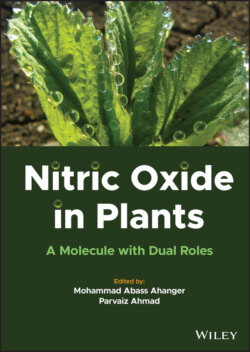Читать книгу Nitric Oxide in Plants - Группа авторов - Страница 8
1.1 Introduction
ОглавлениеNitrogen monoxide, often known as nitric oxide, is a physiologically active chemical that is widely used in animal and plant signaling mechanisms. In plants and animals, it is an intracellular and intercellular signaling molecule with a variety of regulatory roles. Its functions in the central nervous, cardiovascular, and immunological systems, platelet inhibition, programmed cell death, and host responses to infection, among other things, have been widely studied in animals.
Because of the presence of an unpaired electron, it is a highly reactive gaseous molecule that occurs with oxygen in a variety of reduced states such as nitroxyl ion (NO−), nitric oxide free radical (NO•), and nitrosonium (NO+). These NO-derived molecules are referred to as reactive nitrogen species (RNS). NO influences signaling in biological systems through a variety of mechanisms. The interaction of NO• with O2 results in the formation of several redox compounds (including NO2•, N2O3, and N2O4), which may react with cellular amines and thiols or simply change to form the metabolites nitrogen dioxide radical (NO2−) and nitrate (NO3−) (Wendehenne et al. 2001). NO combines with dioxygen to form NO2 or with reactive oxygen species (ROS) to form peroxynitrite (ONOO−), which triggers cellular damage. NO• facilitates electrophilic assault on reactive sulfur, oxygen, nitrogen, and aromatic carbon centers, with thiols being the most reactive of the reactive teams. Nitrosation is the name given to this natural process. Nitrosation of numerous enzymes or proteins results in chemical change, which may affect the function of those entities. These alterations are reversible, and supermolecule nitrosation–denitrosation might be a crucial mechanism for controlling signal transduction (Hayat et al. 2010).
In contrast to the mammalian system, the cellular/subcellular localization of NO production in plants is exceedingly diverse and contentious. The production of NO in plants is determined by the plant’s physiological condition. This includes NO production during root development, stomatal movement control, blooming, plant component expansion, and leaf senescence (Neill et al. 2002; Mishina et al. 2007). NO is produced in plants through nonenzymatic and accelerator systems, depending on the plant species, organ, or tissue, as well as the plant’s state and ever-changing environmental circumstances. The most effective recognized NO sources in plants are as a substrate by cytosolic (cNR) and membrane-specific nitrate enzyme (PM-NR), and NO synthesis by many arginine-dependent gas synthase-like activities (NOS).
According to studies, mitochondria are a major source of arginine- and nitrite-dependent NO synthesis in plants. Tischner et al. acquired the first evidence for mitochondrial NO synthesis in plants when they assessed NO production under anoxic conditions from the unicellular blue green alga Chlorella sorokiniana (Tischner et al. 2004). This green alga does not create NO when exposed to nitrate (NO3), but it does create NO when exposed to nitrite (NO2). NO generation was also inhibited by mitochondrial electron transport inhibitors. Shortly after, mitochondrial NO synthesis in higher plants was discovered. Gupta et al. discovered mitochondrial NO production in barley plants grown in anoxic conditions (Gupta and Kaiser 2010). Under anoxic circumstances, a tobacco Nia 1, 2 (nitrate reductase-deficient) cell suspension was able to manufacture NO from exogenous nitrite, despite the absence of nitrate reductase (which can also manufacture NO from nitrite) (Gupta et al. 2011). Other putative NO producers in plants include xanthine oxido-reductase, peroxidase, and cytochrome P450. NO is a ubiquitous chemical that is found in all eukaryotes. The NR system is by far the most effective and well-characterized mechanism for NO generation in plants. In this case, the cytosolic NR mostly catalyzes the reduction of nitrate to NADH as the predominant negatron donor. NR’s NAD(P)H-dependent NO production has been demonstrated in vitro and in vivo (Rockel et al. 2002). The biological significance of NR activity as a source of NO was first shown in Arabidopsis guard cells by Desikan et al. (2002). The peroxisomal catalyst organic compound enzyme can also catalyze group reduction to NO (XOR). XOR activity in pea (Pisum sativum) leaves is linked to peroxisomes, and as a result, the possibility of interaction between the construction of reactive chemical elements and reactive gas species (ROS and RNS, respectively) has been suggested (del Río et al. 2004). NO production in animals was demonstrated by a chemical reaction of arginine transforming into citrulline mediated by the enzyme NO synthase (Palmer et al. 1987). Following the discovery of a purpose for NO in plants in 1998 (Delledonne et al. 1998; Durner et al. 1998), several researchers began to look for NOS activity in plants, despite the fact that the Arabidopsis thaliana ordering failed to reveal any factor with significant similarity to animal NOS (Moreau et al. 2010).
